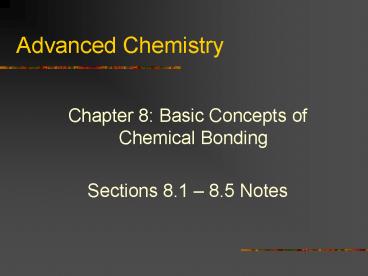Advanced Chemistry PowerPoint PPT Presentation
1 / 18
Title: Advanced Chemistry
1
Advanced Chemistry
- Chapter 8 Basic Concepts of Chemical Bonding
- Sections 8.1 8.5 Notes
2
Whats a Chemical Bond?
- Whenever atoms or ions are strongly attached to
one another, we say that there is a chemical bond - Three types of Chemical Bonds
- Metallic
- Ionic
- Covalent
3
Bond Types Brief Review
- Ionic
- Refers to the electrostatic forces that exist
between ions of opposite charge - Covalent
- Results from the sharing of electrons between
nonmetals - Metallic
- Are relatively freely moving electrons found
between metals
4
Bond Polarity
- Bond polarity is determine by differences in
electronegativity
Non-Polar Covalent 0.0 Polar Covalent 0.1-
1.9 Ionic Bond gt2.0
5
Dipole Moments
- Covalent compounds with differences in
electronegativity produce dipole moments, thats
why they are polar molecules! - Dipole moment increases with charge!
u Qr
6
Calculating Dipole Moments
- u Qr
- Where
- u dipole moment measured in debyes (D)
- Q product of charges of atoms involved in bond
- r separation of charge in meters (m)
- Convert using 1D 3.34 x 10-30 Cm
The distance between the centers (bond length) of
H and Cl atoms in the HCl molecule is 1.27
Angstrom. A) Calculate the dipole moment using a
1 and -1 charge respectively
7
Ionic Bonding
- Attraction between ions..generally metals and
nonmetals..this you know.. - But what happens to energy in ion formation?
- Forming a cation (metals losing an electron) is
an endothermic process..meaning energy is put in
to remove an electron - Forming a anion (done by nonmetals) is an
exothermic process - The difference between the processes is the
overall energy change for one mole of reactant
8
Ionic Bonds and Lattice Formation
- The ions are drawn together and a lattice of
ionic structure is formed - The Lattice Energy is the measure of how much
stabilization results from the arranging of
oppositely charged ions in an ionic solid - It is, the energy required to completely separate
a mole of a solid ionic compound into its gaseous
ions
9
Lattice Energy Example
NaCl(s) Na(g) Cl- (g)
?Hlattice 788 kJ/mole
This means the forming of NaCl is highly
exothermic, ?H -788 kJ/mole
10
Lattice Energies
- The large positive endothermic lattice energies
makes ionic bonds strong.. - The strong attractions also make the compounds
hard, brittle materials with high melting points
Potential energy of two interacting charged
particles relates by this equation
Q1Q2
E k
r2
11
Practice Problem
- Which substance would you expect to have the
greatest lattice energy? - AgCl, CuO, or CrN
The greatest lattice energy results from the
largest product of the ionic chargesthus CrN has
(3)(-3) 9
12
Electron Configuration of Ions
- Ions like loose or gain electrons to form
noble-gas electron formations - This results in the most energy-favorable and
stable formation - Even though an increase in ionic states would
result in a higher lattice energy, it is not
enough to remove an electron from a completed
energy level or add to an unfavorable higher
energy level
13
e- configuration of Transition Metals
- Transition metals (d block) cannot reach the
noble gas configuration due to their location on
the table - Sothey achieve stability by loosing electrons
from the highest n shell.. - So, they loose valence electrons first, then as
many d electrons as are required to reach the
charge on the ion
14
Example
- Fe Ar 4s2 3d6
- In forming the Fe3 ion, 2e- are lost from the 4s
subshell and 1 from 3d so - Fe3 Ar 3d5
15
Practice Problem
- Write the electron configuration for Cr3
Ar 3d3
16
Sizes of ions
- Ionic size plays a crucial role in determining
the structure and stability of ionic solids - It determines both the lattice energy of the
solid and the way in which the ions pack in a
solid - Ionic size also determines the properties of ions
in solutions
17
Ion Size
- Ion size depends on nuclear charge, the number of
electrons it possesses, and the orbitals in which
the outer electrons exist - Cations are smaller than their parent atoms
- Anions are larger than their parent atoms
- For Ions with the same charge, size increases as
we go down a group in the PT
18
Ion Size and isoelectronic series
- The term isoelectronic means that the ions
possess the same number of electrons - Ex O2-, F-, Na, Mg2 and Al3
- All have the configuration of Neon
- The nuclear charge increases while of e remain
the sameso - Radius decreases due to larger attractive force
between nucleus and electrons
end

